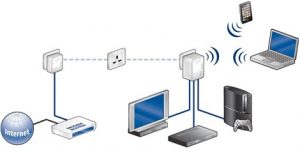As the name suggests, powerline networking uses the electrical wiring in your house to create a network. It requires no new wiring, and the network adds no cost to your electric bill, therefore, power-line networking is one of the cheapest methods of connecting computers in different rooms. With powerline networking, you buy a basic kit, which comes with two Powerline adapters and two short Ethernet cables. One of the Ethernet cables is connected to your router and another to the first of the adapters. You then plug it into the nearest power socket. You connect the second Ethernet cable into the back of the HD TV and into the second adapter. You then plug the second adapter into the nearest power socket. The adapters are designed to auto-detect each other (no drivers, no lengthy configuration process) and auto-connect, enabling data packets to mvoe from router to TV, travelling along the Ethernet cable, into the first adapter, across the electrical wiring in the walls, out into the second adapter and into the TV.
With the introduction of the first HomePlug Powerline standard in 2001, data speeds were limited to a sluggish 14Mbps. But the newest Powerline products now support Gigabit-class networking. Related Article: Beginner’s guide to home mesh WiFi router systems.
Why use Powerline networking?
Powerline is a great bridging technology, useful for extending the reach of a home network to places where wireless coverage is poor, or where you need the fastest connection possible. It is also ideal for connecting old devices to the Internet that don’t have built-in Wi-Fi connectivity, avoiding overcrowding your living room with Ethernet cables. Powerline technology is very secure. As data is sent across the copper wiring in your home, it can’t be hacked or misused from the outside by hackers and spammers. A modern Powerline kit also allows you to password protect your adapters, adding an extra layer of protection. Setting up powerline Ethernet is relatively simple. Plug them into the wall, connect the Ethernet cables, and generally you’re good to go. However, there are some short comings of powerline networking technology. Connections Are Limited to Your House and therefore sharing data with say a neighbor or someone in another house is not possible. If you live in an apartment, however, there’s a chance your neighbors could pick up a signal, since the wiring is shared in some cases. Surge protectors can protect your computer, but they also mess up powerline Ethernet signals. Plugging a powerline Ethernet device into a power line with surge protection will severely limit your potential speed, if not stop the device from working altogether. The electrical wiring in the average house can support a variety of frequencies. As electricity uses 50/60Hz signals, extra data can be transported along the same wiring at much higher frequencies, without causing any further interference. Therefore, why not use this chance to connect some of your devices and save yourself some money? If you have any questions or user experiences, please leave them in the comments below.

